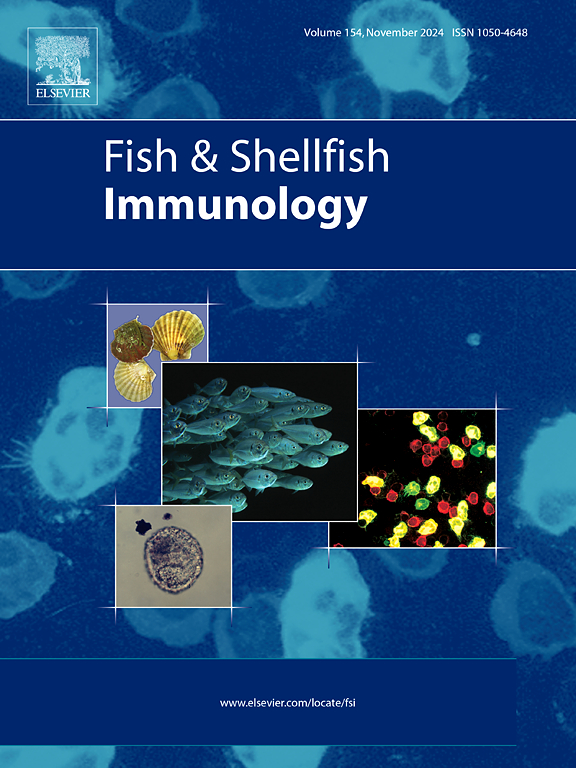Evaluation of a tilapia epitopes vaccine against Streptococcus agalactiae based on phage display technology
IF 3.9
2区 农林科学
Q1 FISHERIES
引用次数: 0
Abstract
Tilapia ranks among the world's leading aquaculture species, but Streptococcus agalactiae (S. agalactiae) severely limits the growth of the global tilapia industry. Vaccination has been proven to be a promising strategy for controlling this disease. In this study, a Ph.D.-12 phage display library was screened using serum from S. agalactiae survivors, leading to the identification and synthesis of two peptides (P1 and P2). Subsequently, an epitope vaccine was prepared by combining the peptide with adjuvant, and tilapia were immunized with a prime-boost strategy to evaluate its protective effect. Serum and tissue samples of immunized fish were collected periodically after the primary immunization, and the immunization effect was evaluated by combining enzyme-linked immunosorbent assay (ELISA), enzyme activity assays and quantitative real-time PCR (qRT-PCR). The results showed that the vaccine significantly enhanced host immune responses, including elevated specific antibody titers and upregulation of CD8, a marker of T cell activation. Notably, the epitope vaccine conferred protection against S. agalactiae challenge within 14 days post-challenge with a survival rate of up to 54.29 % in the group treated with Adjuvant-P1 (20 μg/g). Unlike traditional reverse vaccinology approaches, this method employed phage display to directly identify conformational epitopes, leading to the discovery of new conserved epitopes and suggesting that P1 and P2 peptide mimotopes hold potential as S. agalactiae candidate antigens. However, while this study provided preliminary evidence of the vaccine's efficacy against S. agalactiae over a 35-day period, further validation of the vaccine's durability and generalizability by extending the observation window and using different S. agalactiae strains is necessary. In conclusion, two mimotopes against S. agalactiae were directly identified by phage display in this study, which lays the foundation for the development of highly efficient and chemically synthesizable S. agalactiae vaccines for tilapia, and contributes to the promotion of the sustainable development of the tilapia industry.
基于噬菌体展示技术的罗非鱼抗无乳链球菌表位疫苗的评价。
罗非鱼是世界领先的水产养殖物种之一,但无乳链球菌(S. agalactiae)严重限制了全球罗非鱼产业的发展。疫苗接种已被证明是控制这种疾病的一种有希望的策略。本研究利用无乳链球菌(S. agalactiae)幸存者血清筛选ph . d . 12噬菌体展示文库,鉴定并合成了两个肽(P1和P2)。随后,将该肽与佐剂结合制备抗原表位疫苗,并对罗非鱼进行始发-强化免疫,评价其保护作用。初次免疫后定期采集免疫鱼的血清和组织样本,结合酶联免疫吸附试验(ELISA)、酶活性测定和实时荧光定量PCR (qRT-PCR)评价免疫效果。结果表明,该疫苗显著增强了宿主的免疫应答,包括特异性抗体滴度升高和CD8 (T细胞活化的标志)的上调。值得注意的是,佐剂p1 (20 μg/g)组的表位疫苗在攻击后14天内对无乳链球菌的攻击具有保护作用,存活率高达54.29%。与传统的反向疫苗学方法不同,该方法利用噬菌体展示直接鉴定构象表位,从而发现了新的保守表位,并表明P1和P2肽模位具有作为无乳链球菌候选抗原的潜力。然而,尽管本研究在35天内提供了疫苗对无乳链球菌有效的初步证据,但有必要通过延长观察窗口和使用不同的无乳链球菌菌株来进一步验证疫苗的持久性和普遍性。综上所述,本研究通过噬菌体展示技术直接鉴定出两种抗无乳链球菌的拟合酶,为开发高效、化学可合成的罗非鱼无乳链球菌疫苗奠定基础,有助于促进罗非鱼产业的可持续发展。
本文章由计算机程序翻译,如有差异,请以英文原文为准。
求助全文
约1分钟内获得全文
求助全文
来源期刊

Fish & shellfish immunology
农林科学-海洋与淡水生物学
CiteScore
7.50
自引率
19.10%
发文量
750
审稿时长
68 days
期刊介绍:
Fish and Shellfish Immunology rapidly publishes high-quality, peer-refereed contributions in the expanding fields of fish and shellfish immunology. It presents studies on the basic mechanisms of both the specific and non-specific defense systems, the cells, tissues, and humoral factors involved, their dependence on environmental and intrinsic factors, response to pathogens, response to vaccination, and applied studies on the development of specific vaccines for use in the aquaculture industry.
 求助内容:
求助内容: 应助结果提醒方式:
应助结果提醒方式:


